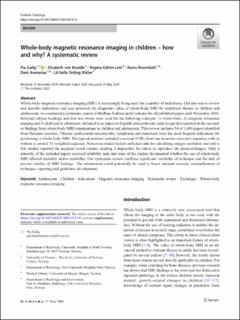| dc.contributor.author | Zadig, Pia Karin Karlsen | |
| dc.contributor.author | von Brandis, Elisabeth | |
| dc.contributor.author | Lein, Regina Küfner | |
| dc.contributor.author | Rosendahl, Karen | |
| dc.contributor.author | Avenarius, Derk | |
| dc.contributor.author | Müller, Lil-Sofie Ording | |
| dc.date.accessioned | 2021-02-19T11:50:52Z | |
| dc.date.available | 2021-02-19T11:50:52Z | |
| dc.date.created | 2020-07-07T13:05:13Z | |
| dc.date.issued | 2021 | |
| dc.Published | Pediatric Radiology. 2020, 1-11. | |
| dc.identifier.issn | 0301-0449 | |
| dc.identifier.uri | https://hdl.handle.net/11250/2729204 | |
| dc.description.abstract | Whole-body magnetic resonance imaging (MRI) is increasingly being used for a number of indications. Our aim was to review and describe indications and scan protocols for diagnostic value of whole-body MRI for multifocal disease in children and adolescents, we conducted a systematic search in Medline, Embase and Cochrane for all published papers until November 2018. Relevant subject headings and free text words were used for the following concepts: 1) whole-body, 2) magnetic resonance imaging and 3) child and/or adolescent. Included were papers in English with a relevant study design that reported on the use and/or findings from whole-body MRI examinations in children and adolescents. This review includes 54 of 1,609 papers identified from literature searches. Chronic nonbacterial osteomyelitis, lymphoma and metastasis were the most frequent indications for performing a whole-body MRI. The typical protocol included a coronal STIR (short tau inversion recovery) sequence with or without a coronal T1-weighted sequence. Numerous studies lacked sufficient data for calculating images resolution and only a few studies reported the acquired voxel volume, making it impossible for others to reproduce the protocol/images. Only a minority of the included papers assessed reliability tests and none of the studies documented whether the use of whole-body MRI affected mortality and/or morbidity. Our systematic review confirms significant variability of technique and the lack of proven validity of MRI findings. The information could potentially be used to boost attempts towards standardization of technique, reporting and guidelines development. | en_US |
| dc.language.iso | eng | en_US |
| dc.publisher | Springer | en_US |
| dc.rights | Navngivelse 4.0 Internasjonal | * |
| dc.rights.uri | http://creativecommons.org/licenses/by/4.0/deed.no | * |
| dc.title | Whole-body magnetic resonance imaging in children – how and why? A systematic review | en_US |
| dc.type | Journal article | en_US |
| dc.type | Peer reviewed | en_US |
| dc.description.version | publishedVersion | en_US |
| dc.rights.holder | Copyright The Author(s) 2020. | en_US |
| cristin.ispublished | true | |
| cristin.fulltext | original | |
| cristin.qualitycode | 1 | |
| dc.identifier.doi | 10.1007/s00247-020-04735-9 | |
| dc.identifier.cristin | 1818824 | |
| dc.source.journal | Pediatric Radiology | en_US |
| dc.source.pagenumber | 14-24 | en_US |
| dc.identifier.citation | Pediatric Radiology. 2021, 51, 14-24. | en_US |
| dc.source.volume | 51 | en_US |

